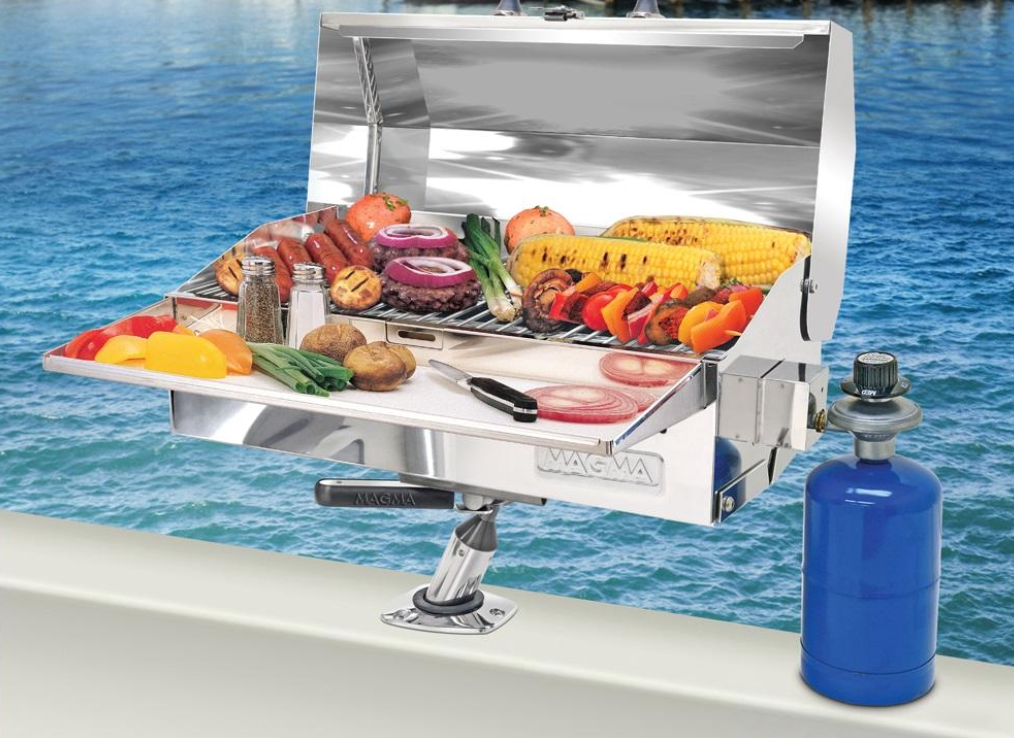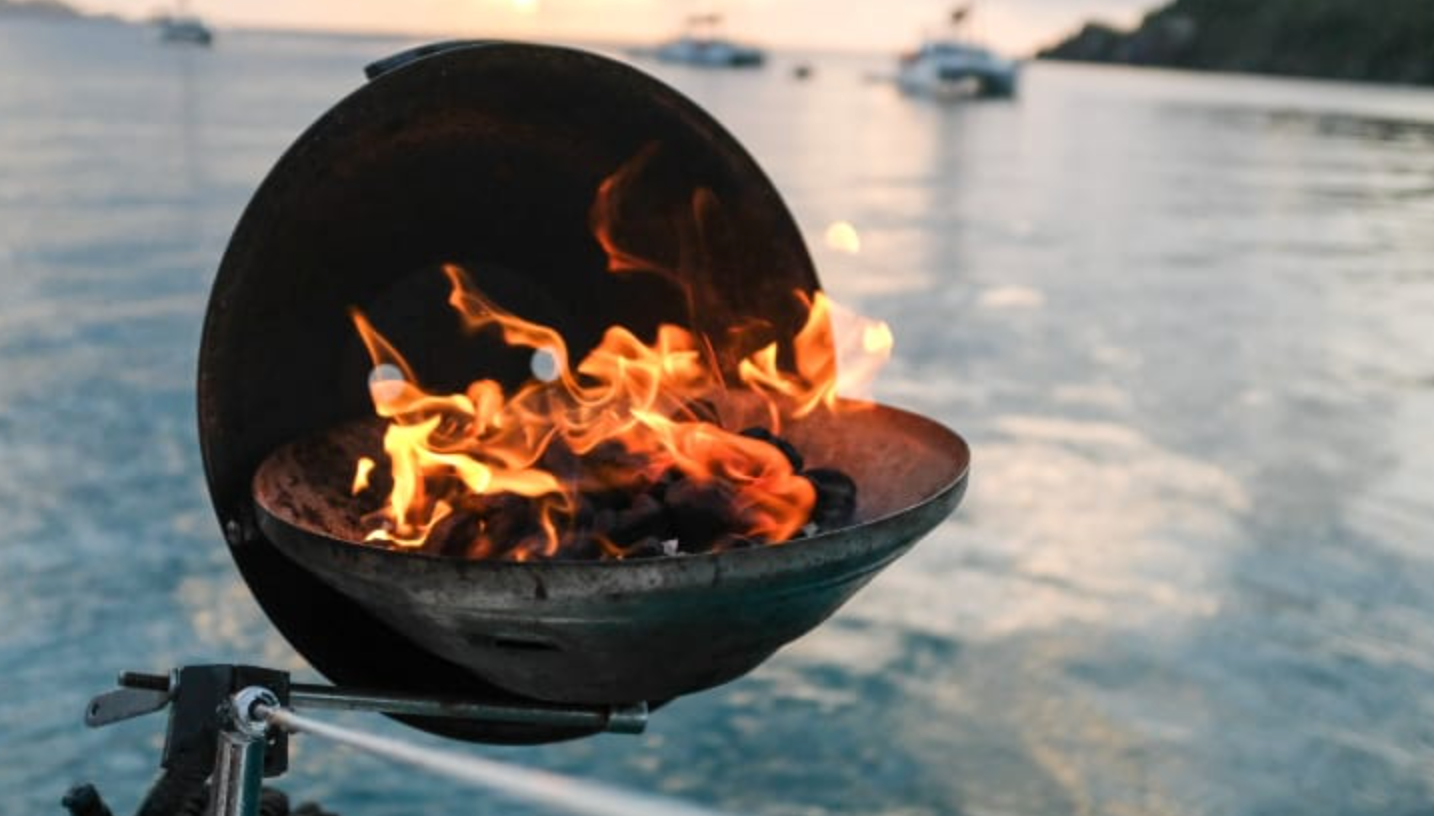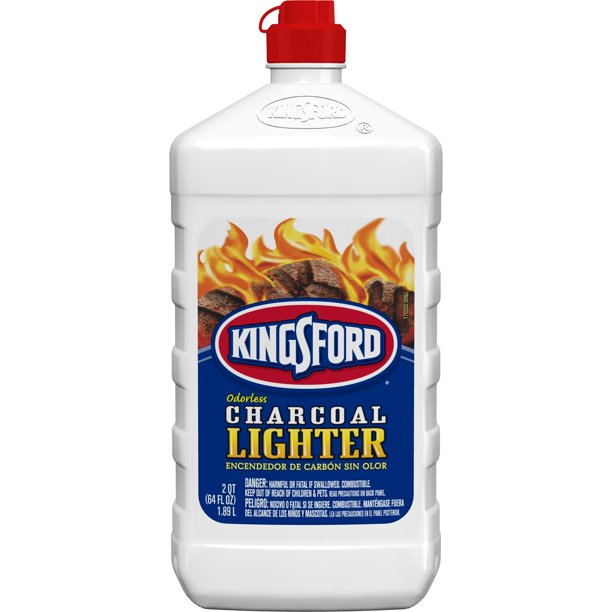Grill Safety and Installation: Barbecuing On a Boat
The mouthwatering aroma of grilling burgers wafting through the evening air, the sound of brats hissing and popping as they near peak perfection. Because grills are located above decks, boaters tend to treat them with a more cavalier attitude when it comes to safety — bad move. According to the Insurance Information Institute, barbecues result in more than 2,000 fires, in excess of 300 grill-related injuries and at least three deaths annually. Let’s take a look at how you can keep “the king of the coals” from becoming a barbecue statistic.
Grill Selection
When it comes to grill selection the three primary choices (based on fuel) are charcoal, liquid propane gas (LPG) and electric, each of which comes with pros and cons.
Charcoal grills can be a challenge to light, but they stay lit afterwards in even the strongest winds. Staying lit is good for cooking, but this inability to shut off the grill in the event of an emergency (accidentally spilling those hot coals for example) is a minus. They’re messy to use, clean and fuel storage can be a pain. They also need to be refilled during extended grilling periods.
Gas grills are easier to light, offer better temperature control and are easier to clean, although they can be more difficult to keep lit in a stiff breeze.
Electric grills are easy to power up (no worries about them going out), offer great temperature control and are easy to clean. They do require a source of AC power, however, which means having a generator onboard or use at the dock only.
Location, Location
Installation-wise, where will the grill be used on a boat? Will it be clamped to the cockpit railing or utilize a rod-holder style mount? Is the chosen location well clear of flammable items and located so that the grill doesn’t interfere with hatches, dinghy davits, etc? If removable, where will it be stowed after use? Where can the fuel (particularly propane) be safely stored above decks?
Grill Safety Tips
While electric grills also have safety requirements, the following tips are primarily directed towards charcoal and gas grills (due to their use of combustion). We’ll discuss safety tips for each separately in a bit, but first let’s look at some general, common-sense tips that can be applied when using most any grill.
Read the owner’s manual.
As with any piece of equipment, the first safety step is reading the owner’s manual. It contains information on everything from assembly to safe operation tips. Still have questions not answered in the manual? Don’t be shy — give the manufacturer a call to clarify (write their consumer service phone number on the front page of the manual for easy reference).
Always Grill Above Decks in an Open Area
Barbecue grills are designed for use above decks in a well-ventilated area. Never grill belowdecks or inside an enclosed area, such as cockpit with full canvas curtains in place. In both cases, carbon monoxide can accumulate with lethal results.
Securely Mount Grill Before Use
Ensure that the grill is firmly mounted in place and stable. Never use portable, camping-type grills that can easily slide around or tip over. Grills should also be mounted where people and pets can’t accidentally come in contact with them. Never try to move a hot grill. Instead, allow the grill to completely cool to the touch before trying to relocate or stow it.
Keep it Under Control
Never leave a grill unattended during use and always keep some method of fire control nearby. Options can include a portable fire extinguisher, fire bucket (with a lanyard long enough to reach the water) or fire blanket. A spritzer bottle of water can help with minor flare-ups, but remove food from the grill first if possible. Cleaning the grill regularly by removing grease and fat buildup will reduce the chances of fire and flare-ups as well.
Use Proper Grilling Utensils
Use of long-handled barbecue utensils (tongs, forks, etc) will help reduce burns due to pops and splatters.
Wear Grill-Safe Clothes
No thongs, speedos, or “au natural” grilling, please. On the flip side avoid baggy, frilly clothes and loose, billowing shirts or bikini wraps that can catch fire.
Charcoal Grill Safety Tips
If starter fluid is used, use only charcoal starter fluid (not gas from the dingy jerry can).
- Never add charcoal fluid or any other flammable liquids to the fire once started. Charcoal chimney starters permit starting charcoal using newspapers, etc, without the need for starter fluid. After the grilling is done, let the coals cool completely before disposal.
LPG Grill Safety
Most boat grills utilize small (16.4-ounce/.46 kg) disposable LPG cylinders. Always inspect these for signs of corrosion, dents, gouges or other external damage before use. If any problems are found, dispose of them properly and use another cylinder.
Properly mount the grill outside in a well-ventilated area before connecting the cylinder. Always disconnect and remove the LPG cylinder after use and before stowing.
Store LPG bottles above decks in a well-ventilated area where escaping vapors can only flow overboard. They must also be protected from the weather and mechanical damage.
Possible options include a PVC tube holder or a non-corrosive bag properly mounted to the stern railing (well away from the grill of course).
Never lean over the grill when lighting (or cooking for that matter) and keep the lid open to prevent flare-ups from gas build-up.
By Capt. Frank Lanier
Captain Frank Lanier is a SAMS® Accredited Marine Surveyor with over 40 years of experience in the marine and diving industry. He’s also an author, public speaker, and multiple award-winning journalist with articles on seamanship, marine electronics, vessel maintenance and consumer reports. He can be reached via his website at www.captfklanier.com




